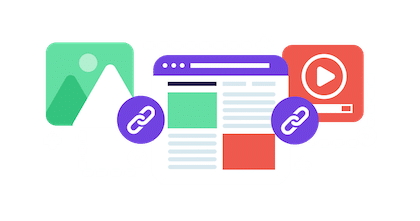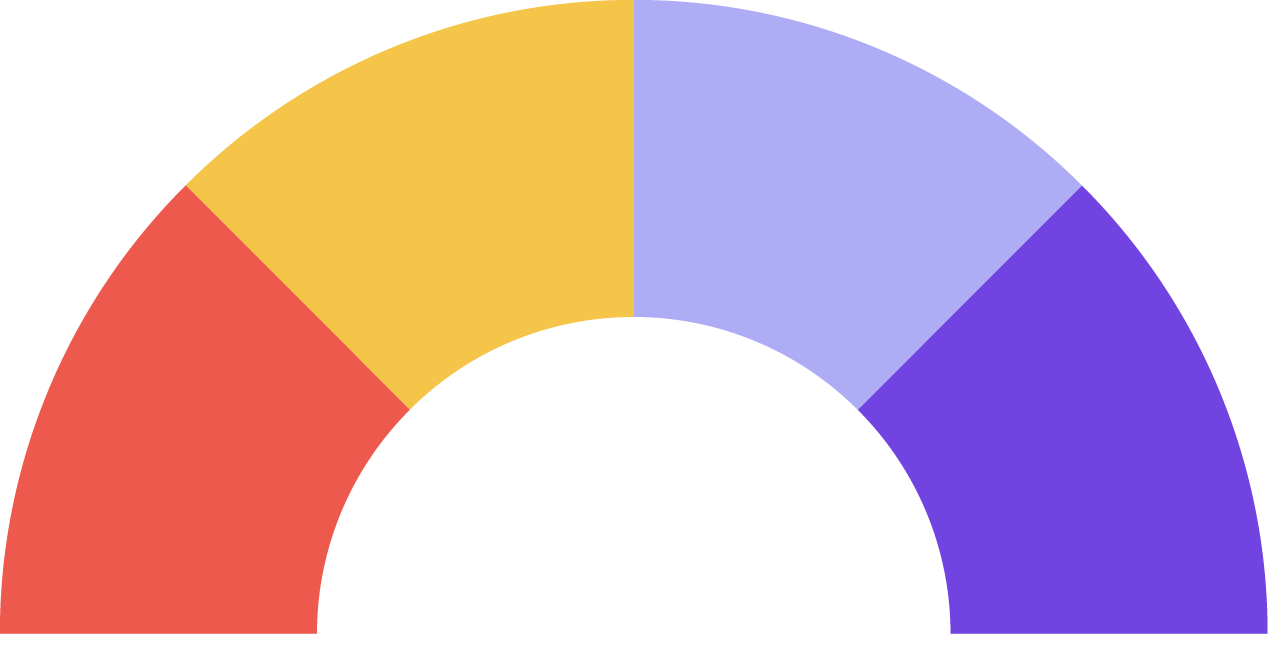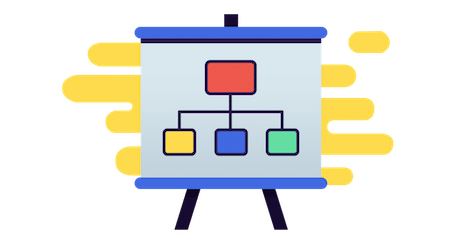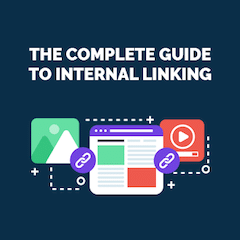
But internal links are equally (if not more) powerful when used correctly.
Best of all they’re really easy to influence when you know how to.
In today’s post, you are going to learn everything there is to know about internal linking.
I’m covering:
- What are internal links (in plain English)
- Internal vs External links
- The importance of internal links
- 7 internal link types and how they pass SEO value
- 13 internal linking strategies you can use to grow your rankings and conversions
And much more!
Let’s get started.
What are Internal Links?
Internal links are hyperlinks that link between web pages on the same website.
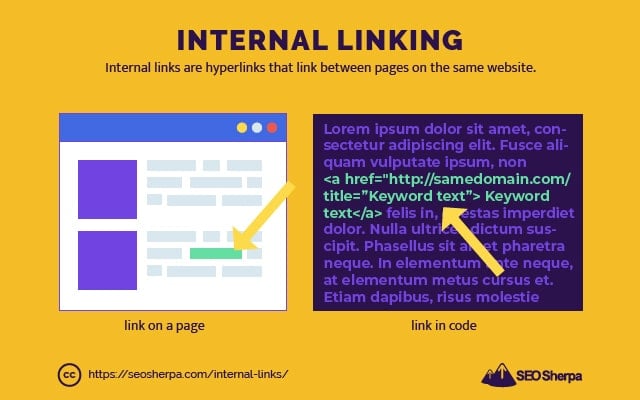
Both users and search engines use internal links to navigate between pages – and in turn, discover new content on a site. Aside from aiding discoverability, internal links pass SEO value and context through link anchor text and surrounding content.
Internal links can be found in a website’s navigation, breadcrumbs, and the main body copy on a page.
Internal Links vs External Links
The difference between internal and external links is that internal links point to web pages on the same website, whereas external links link out to pages on other websites.
Notice I use the word website not domain. This is important.
Most definitions describe internal links as hyperlinks between pages on the same domain – but that’s not true. Let me explain:
On this website I have two domains:
- seosherpa.com (root domain)
- partners.seosherpa.com (subdomain)
When I link from a page on seosherpa.com to a page on partners.seosherpa.com I am linking internally, not externally – despite my linking between two domains.
On the other hand, a link between two subdomains on blogger.com would be considered an external link – as those blog domains would (likely) have two different owners.
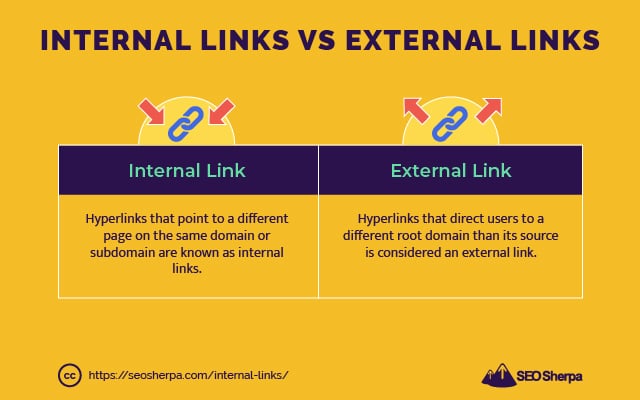
Put another way, if you can add a hyperlink between two pages, and the pages live on the same root domain, then those links are considered internal links.
Every website uses both internal and external links.
Why are Internal Links Important for SEO?
Internal links help search engines discover, index, and understand all of the pages on your website.
Not just that…
They also provide search engines with context about a webpage, its’ relationship to other pages, and how important the page is compared to others on your website.
If you know how you can use internal links to your advantage and improve your site’s rankings in SERPs.
In a moment I’ll show you precisely how to use internal links to improve your SEO.
But first, let’s break down in detail why internal links matter:
(1). Search Engines Use Internal Links to Crawl Your Website
Google and other search engines crawl links between web pages to discover new content.
Therefore, if a URL doesn’t have links pointing to it – or isn’t referenced in a sitemap – Google won’t find it. We call URLs without links pointing to them “orphan pages.”
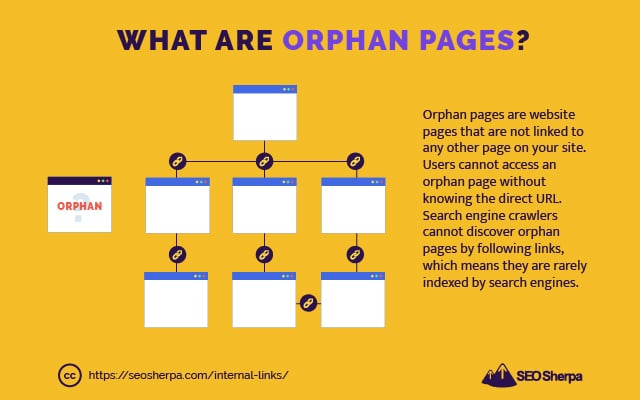
It goes without saying, if Google cannot find a URL because it’s orphaned – the page won’t rank.
On the other hand, the more links a page has, the more likely Google will discover it – and know it’s important.
(2). Internal Links Pass Authority (AKA PageRank)
A page with a lot of links will be deemed more meaningful than a page with fewer links pointing to it.
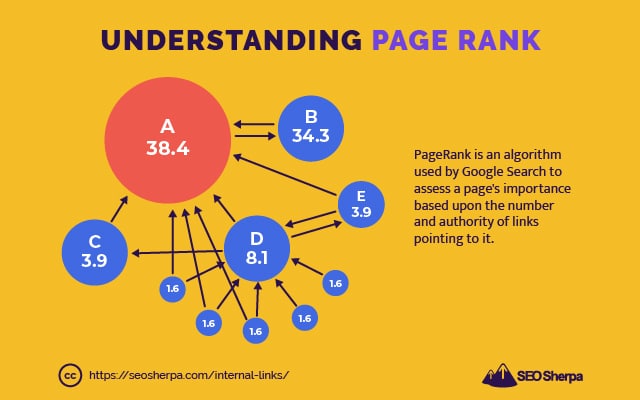
That’s especially true when pages are linked from a website’s main navigation.
When you link to a page from your main nav you are telling Google “Hey, this page is important. I want users to find it.”
And in turn, more PageRank passes to it – and your rankings improve.
(3). Internal Links Give Search Engines Context
The content in which an internal link is placed tells Google a lot about the page being linked to.
For example, here’s an internal link to a page on my site:
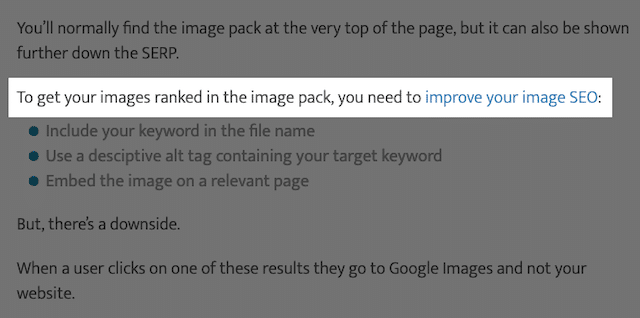
The anchor text and surrounding content help users AND Google know the page I’m linking to is about “Image SEO.”
With that in mind, an internal link within a sentence, paragraph, and subheading that’s on-topic, will have much more weight than one that’s not.
(4). Internal Links Improve UX and Dwell Time
Internal links help users find related content, and that’s GREAT for user experience.
They’re helpful for dwell time too.
Dwell time is an indicator of searcher satisfaction:
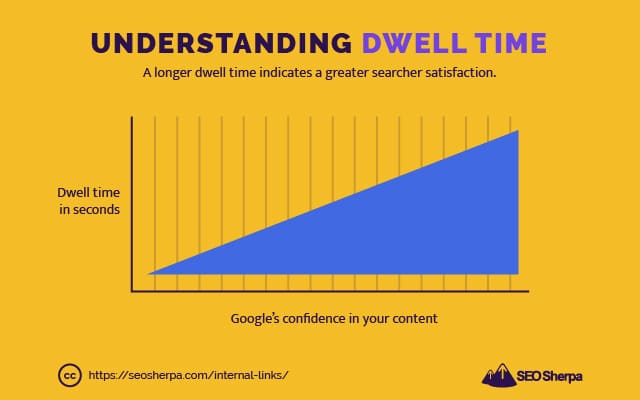
It’s measured by the amount of time a Google searcher spends on a webpage before returning to the SERPs.
In modern-day SEO, dwell time is considered an important ranking signal.
You can influence dwell time by linking to other pages – thus keeping users on-site for longer.
Not All Links Are Equal: 7 Types of Internal Links (and How They Pass SEO Value)
Just like backlinks – some internal links are more valuable than others.
The most significant measure of internal link value is the likelihood a user will click a link based on the features related to it:
- Color
- Size
- Font style
- Anchor text
And other factors.
This is known as the Reasonable Surfer Model and is one of Google’s patents.
Next, I’ll dissect the different types of internal links from most to least valuable.
Body Content Links
Body content links (AKA “contextual links”) are your in-content links pointing to related topics and articles.
As you already know, the more context surrounding a link, the more useful it is to Google.
Body content links by nature are wrapped by lots of valuable information such as headers, paragraph copy, and images. This gives Google a lot of meaning by which to understand each page you are linking to.
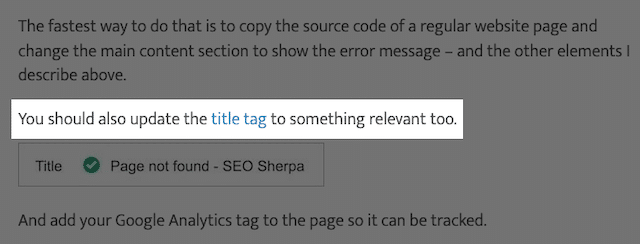
Another important attribute of body copy links is that they are intentionally placed.
Unlike navigation links which are built into the framework of your website, body copy links are manually inserted, whether to cite a source or provide more information.
Given the intentionality of links like these – it makes sense that they pass more SEO value than other link types.
Breadcrumb Links
Not every website has breadcrumb links – nor does every website need them.
If like ours, your website has a flat structure with few categories and subcategories, then you can do away with breadcrumbs.
On the other hand, if your site has multiple sections (like an e-commerce website) then implementing breadcrumb links will aid user experience – and rankings.
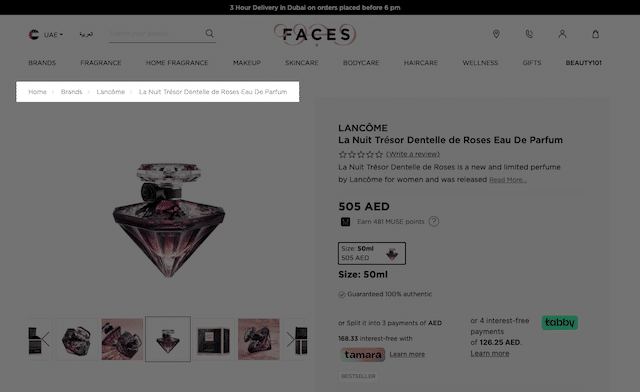
From a user standpoint, breadcrumbs offer an easy way for users to know where they are on your site and jump back to any point in your site’s hierarchy.
From a search engine standpoint, breadcrumbs aid crawling and inform bots how your content is organized.
What’s cool is that once breadcrumbs are built into your site they’ll appear on any new page you create and pass along link juice automatically.
Main Navigation Links
Main navigation links are the links that appear in your primary navigation.
Good main-nav links will help users find your website’s popular and important content.
This could be your main products, services, about, or contact page.
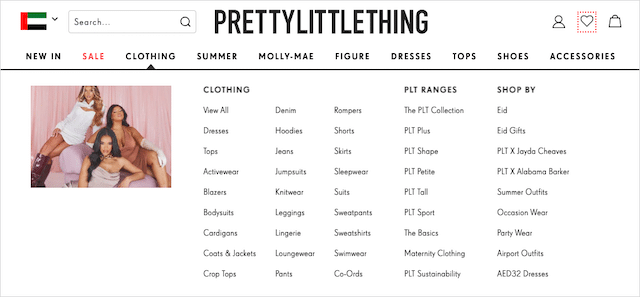
Since navigational links appear in the main header they communicate a lot about your site’s hierarchy and site structure, but they provide far less context than body copy links.
Sidebar Links
Sidebar links are most commonly seen on blogs.
When used strategically they can improve user experience, aid crawl-ability, and send link juice to pages hidden deep in your site.
A good use case is to handpick blog posts you want to rank, then place them in a best-of list.
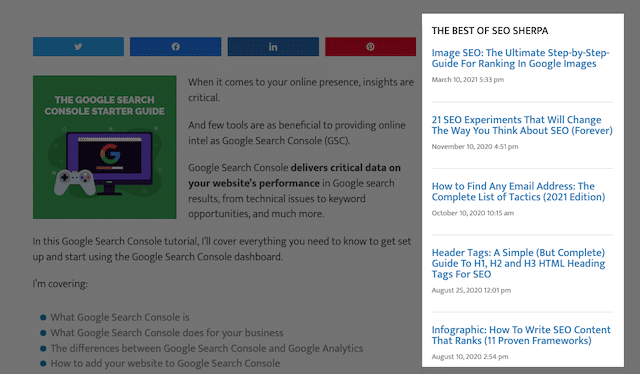
I recommend using descriptive anchor links containing your target keywords.
That’s exactly what I’ve done on the SEO Sherpa blog and it’s given these posts a ranking lift.
Footer Links
Footer links are an important aid to navigation.
They help users who scroll down to the base of a page discover other important pages.
Since they sit at the very bottom of your web pages, they are low down the pecking order in terms of their PageRank passing ability.
But still, it’s important you use them, especially for linking to your contact, privacy, disclaimers, and the about us page.
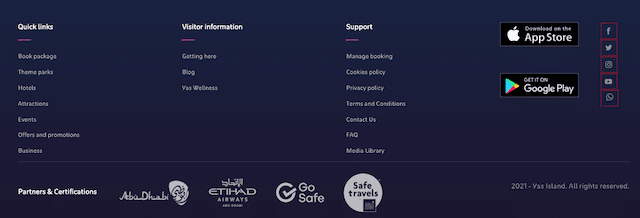
Just like we’ve done for our client Yas Island.
Bookmark Links
Whereas our other internal link types link to other pages on the same website…
Bookmark links – also known as “anchor links” – link to other sections of the same webpage.
You may have noticed I use Bookmark links in some of my blog posts.
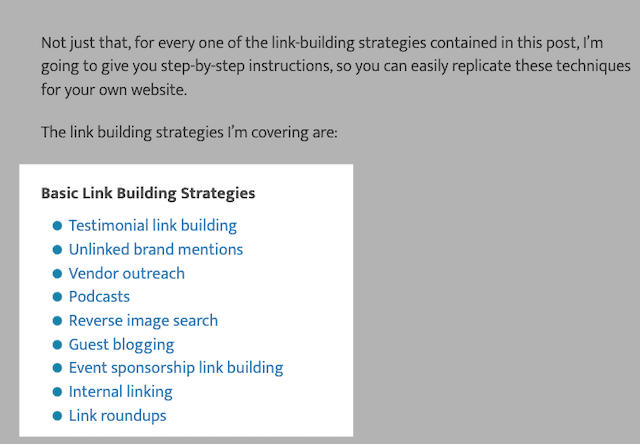
I’ll typically use them at the very top of a post to help users jump to a specific section.
Anchor links are useful for easy navigation around a long-form blog post.
And can even help win site links in SERPs.

They don’t however pass any PageRank, because a page cannot pass juice to itself.
Next/Prev Links
Most blogs and e-commerce websites use “Next/Prev” links.
They’re used to indicate the page is one in a series.

While Google abandoned pagination markup quite some time ago, the use of “Next/Prev” links is still necessary for SEO.
Using this link type when your content is spread across multiple pages will aid the discoverability of deeper content.
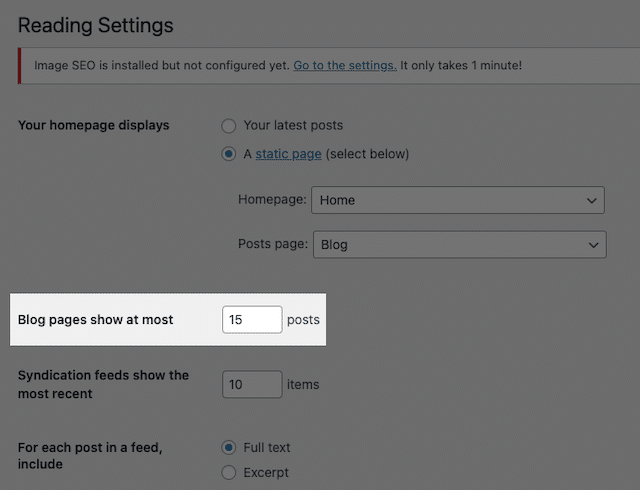
I recommend setting your blog to show at least the 15 latest posts to ensure link equity flows more effectively through your blog.
15 Internal Linking Strategies (and Best Practices) You Can Leverage Today
Pro-tip – in your blog settings, set your blog feed to 15+ posts per page. This minimizes the pagination sequence and ensures your top post receives a good amount of PageRank.
(1). Add Internal Links Wherever It Helps Your Readers
If you reference one of your products on a page or post, point an internal link to it.
If you reference a topic and have written a blog post on that thing, point an internal link to it.
Basically, if it helps your audience, point an internal link to it.
Whenever I write new content I look for opportunities to reference my old content.
Here is an example from a recent blog post:
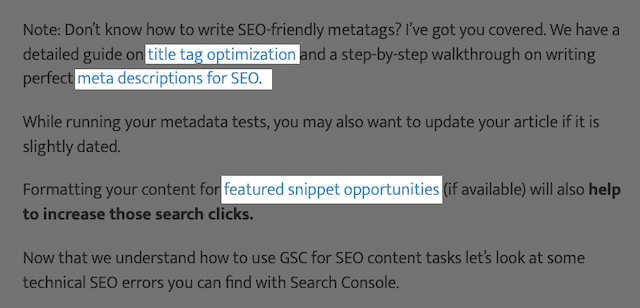
I mention various on-page SEO concepts and have linked to blog posts I’ve written on those topics.
Great for the reader since they can click to learn more, should they want to.
Great for me as it channels ranking signals through to my post and pages.
(2). Use Keyword-Rich Anchor Text
When it comes to building backlinks, use keyword-rich anchor text cautiously.
For internal links, different rules apply.
You can use the same anchor text across multiple internal links with little chance of a slap from Google.
Infact, Google recommends using keywords that describe the page you are linking to:

Take this link from a post on my blog:

It’s crystal clear what to expect from the post being linked to.
Still, it’s a missed opportunity if all you do is use the same anchor text over and over.
That’s why I like to mix up my internal links and use a variety of different anchors.

This provides Google with even more information about the page being linked to and helps boost my rankings for long-tail keywords.
(3). Drop Internal Links High Up On Your Page
There are 2 reasons why you want to place internal links at the top of your page:
First, links displayed prominently on your site are more likely to get clicks.
Google sees links with more click-through potential as important.
This means links higher on a page have more ranking influence.
Second, internal links high up on your page can reduce your bounce rate and increase your dwell time.
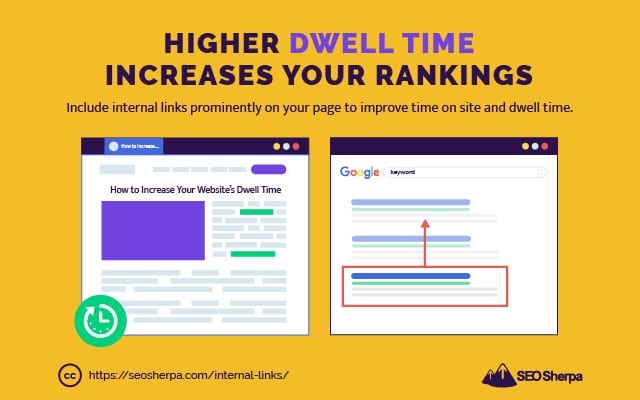
As I pointed out earlier, when Google sees people spending a long time on your site they conclude “users are loving this result, let’s push it up the rankings.”
When you put internal links at the very top of your page, it gives readers something to click on right away
And that will improve your time on site (e.g. Dwell time).
(4). Use Do-Follow Links
When linking internally between pages on your website, use regular followed links.
This ensures the flow of PageRank between your pages:
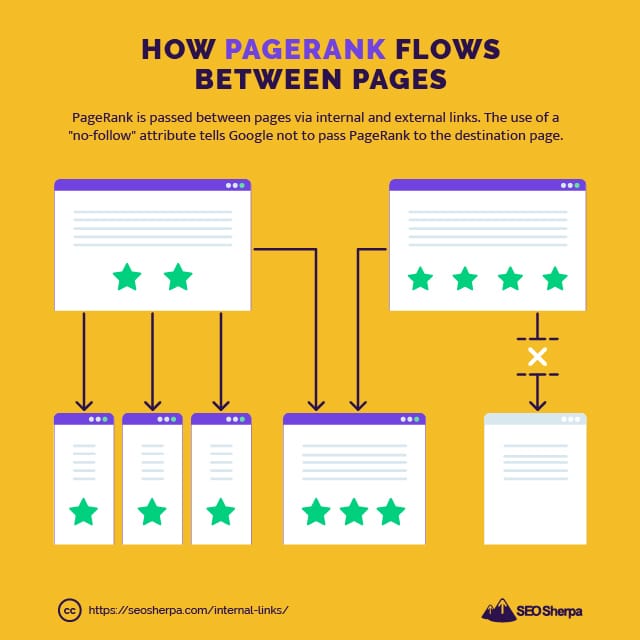
Hint – It’s PageRank that gives your URLs a ranking boost.
This might sound obvious, but I see a lot of website owners using no-follow internal links.
While in theory, you can use no-follow links to restrict PageRank flow to certain pages (and therefore increase PageRank to others) this is the wrong use case.
When you use no-follow links internally, you are saying “I don’t endorse my own content.”
And, that’s not a message you want to give to Google.
(5). Power Up Your Inner Pages with Links From Your Homepage
Your homepage is your website’s most authoritative page, period.
It probably has the most backlinks – and is linked internally from every other page on your website.
For instance, the SEO Sherpa homepage has a URL Rating of 45, the next best page is UR 35.
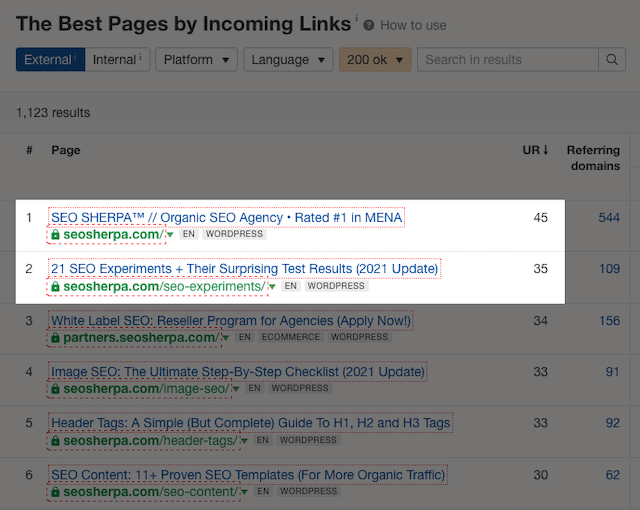
I can use my homepage’s authority to power up inner pages on the site. And that’s exactly what I’ve done using a “read more” block:
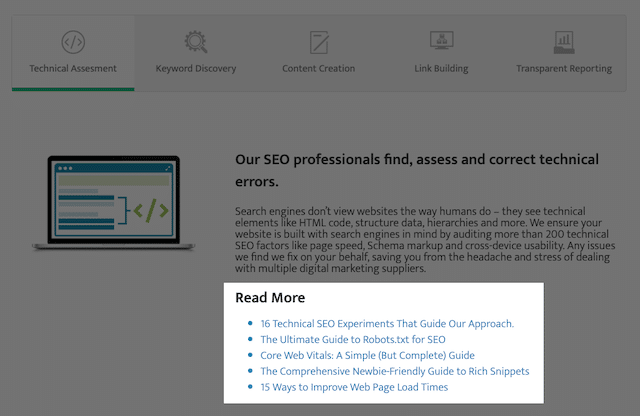
It links strategically to blog posts I want to rank.
(6). Use “site:” Search to Find Internal Link Opportunities
When it comes to internal linking, there’s one (often missed) opportunity that trumps them all:
Linking from your old content to your new content.
As I’m sure you know:
Brand new content needs links to drive up page authority and increase rankings.
Well, your bank of already published content, can be a goldmine of linking possibilities.
But how do you know which page to link from?
Start by searching in Google with the following search operator:
“site:yourdomain.com “keyphrase related to page”
Let’s say I’m looking for internal link opportunities for THIS post, here’s what I’d enter into Google:
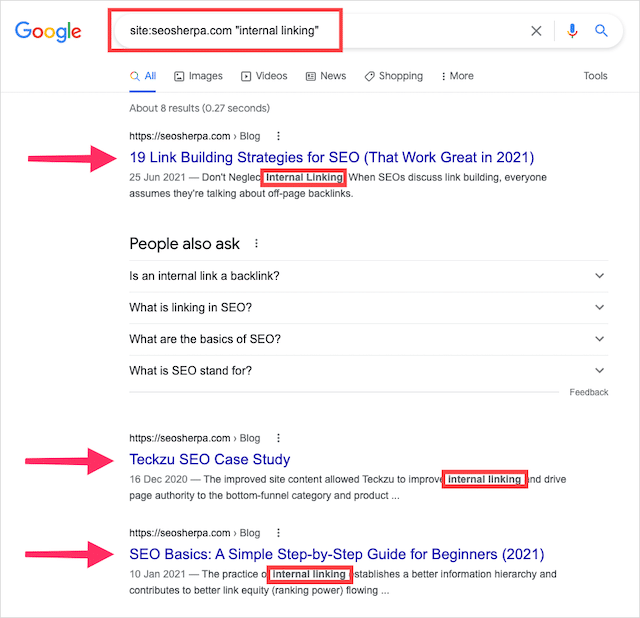
As you see above, Google finds all indexed mentions of that phrase on my site.
All I do next is comb through these pages and insert links (where it makes sense).
This process can be repeated for related phrases too:
- seosherpa.com “internal links”
- seosherpa.com “internal hyperlinks”
And, by doing so I’ll find many relevant places from which to add internal links – and a variety of anchor text options too.
This brings me to my next point.
(7). Don’t Use The Same Anchor Text For Two Different Pages
Let’s say you have two pages on your site.
One page is about keto diet plans and the second is about low-carb diet plans.
You wouldn’t want to link to both pages using the exact same anchor text.
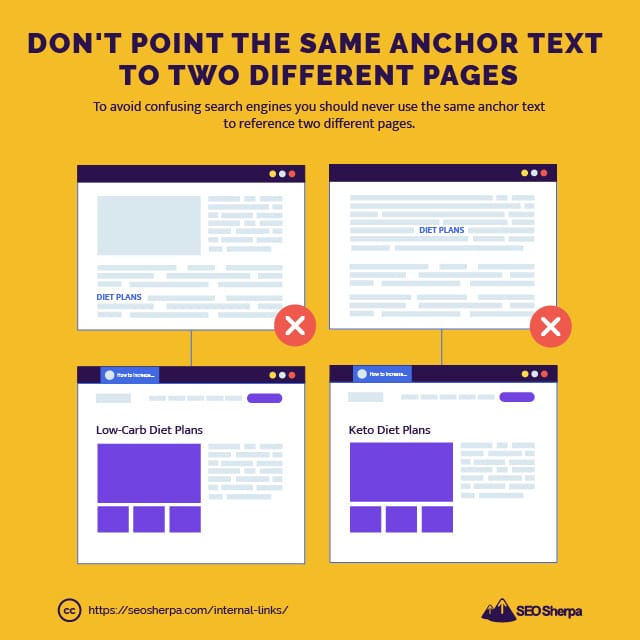
Doing so would bewilder the living daylights out of Google.
To avoid confusing Google as to which page should rank for a certain topic, use unique, descriptive anchor text for each page:
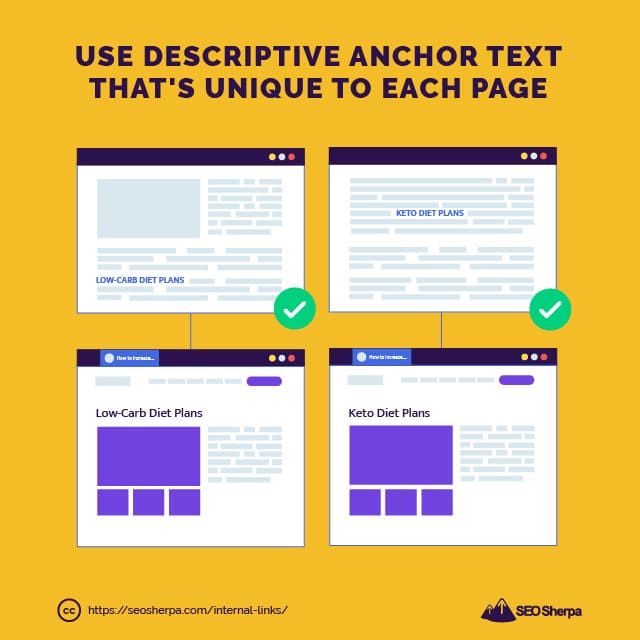
This makes it clear what each page is about.
(8). Optimize for First Link Priority
Often you’ll find yourself linking to the same destination twice from the very same page.
Doing so is totally okay.
Infact, it’s super common, especially if you have many links in your navigation.
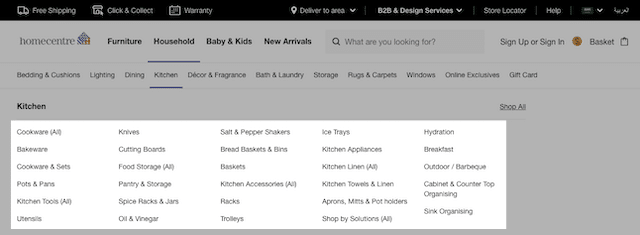
And, also link frequently within the content of your page.
The only tricky piece is anchor text.
Which does Google observe?
The first anchor on the page.
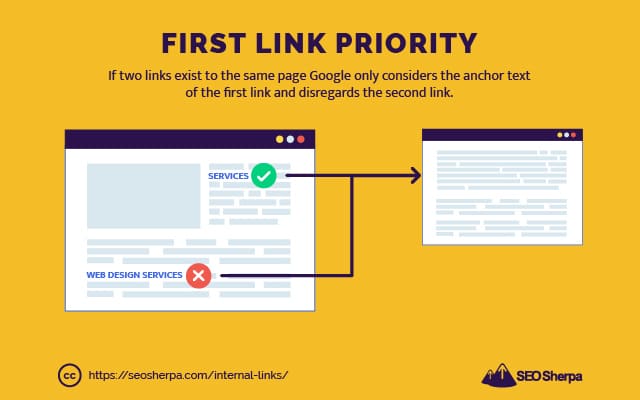
Because of that your navigation link anchor text is really important.
Not only does your navigation result in a ton of links it overrides internal links on a page.
Whether your first link is in your navigation or the content of your page, make sure to optimize it for your target keywords.
(9). Never Automate Internal Linking
There’s a host of tools out there that can automate your internal linking.
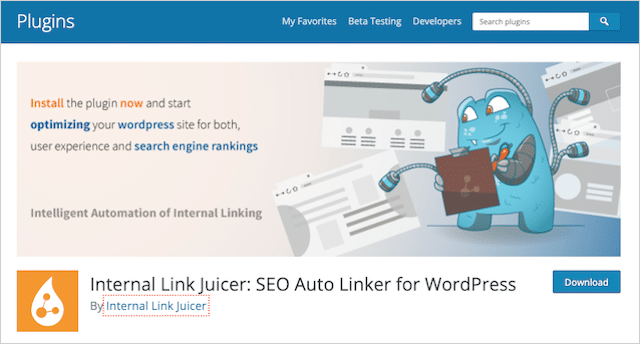
The trouble with you using tools and plugins is you’re turning your internal linking over to AI.
This is problematic for two reasons:
- It’s not strategic – The art of internal linking for SEO is knowing which pages need link juice and how to link to those pages from valuable user-centric places. No plugin can do this as well as you or I, period.
- Over-optimization – I’ve seen tools that have added a thousand exact match anchors to a page seconds after loading the plugin. Automation like that is spammy and leads to ranking catastrophes.
My advice?
Steer clear of automation, and instead add your internal links manually.
(10). Harness Your Power Pages
If you really want to make the most of your internal linking, you can’t go about it haphazardly.
You need to identify and link to your website’s most important pages.
But not just that.
You need to do it from pages that can actually influence rankings.
Here’s how to go about it:
In Ahrefs, open up the “Top Pages by Incoming Links” report to find the most authoritative pages on your site.
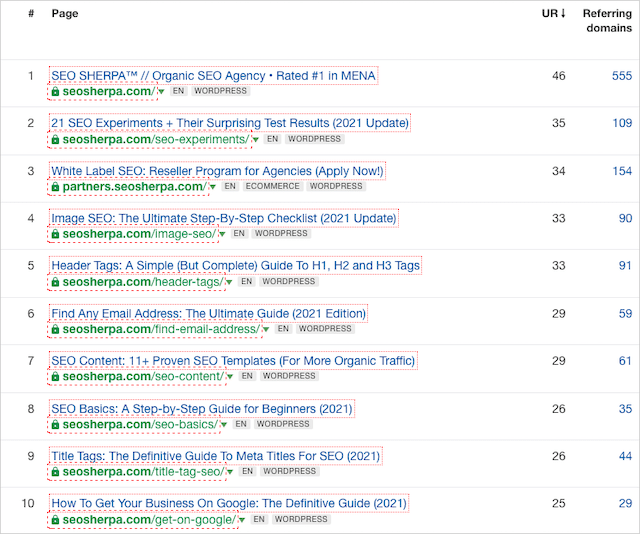
(Links from these power pages have the ability to pass the most link juice)
Once you’ve identified relevant power pages:
Simply link from those pages to the pages that you most want to rank.
For instance:
Ahrefs tells me the most authoritative post on my site is this one about SEO experiments.
I can use the authority of this post to drive link equity to the post you are reading right now.
A quick “CTRL F” search helps me find a relevant passage to link from.
Next, I simply login into my WordPress backend and add the link.

Which is exactly what I did.
(11). Don’t Overdo It (The Rule of 100)
Up to a certain point, the more internal links you add the better.
As I’ve already pointed out, internal links help users and search engines find related content – and pass PageRank through your website.
However, past about 100 links, Google says it could “choose not to follow those links.”

This means the content you are linking to might not get indexed.
Plus, your PageRank would get diluted so much (due to you linking to so many pages), that those links would have little – if any – value.
So as a general rule of thumb, keep the number of links you have per page below 100.
And with that, your internal links will pass along the value.
(12). Use Topic Clusters and Pillar Pages
Imagine topic clusters like buckets of content pages that collectively cover a broad concept.
Each topic cluster has one pillar page and many supporting cluster pages.
Each of these pages is interlinked:
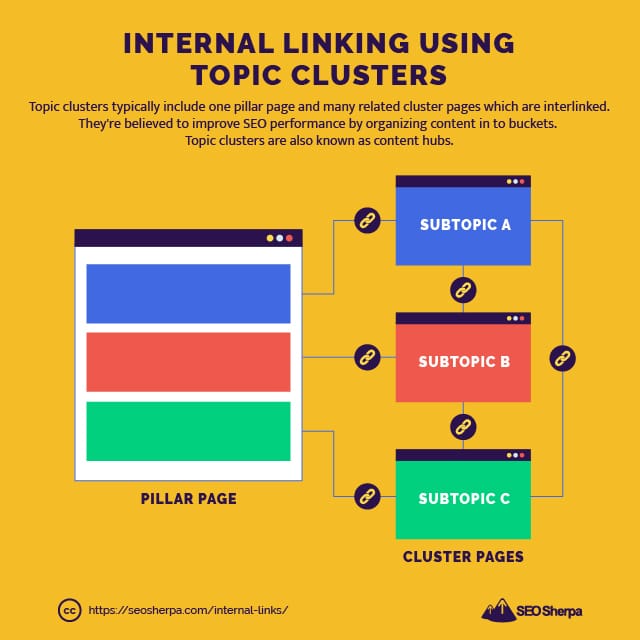
Using topic clusters as part of an internal linking strategy is helpful because they form hubs of relevant content.
When Google crawls these hubs, immediately it’ll know what they’re about.
But to be honest, I don’t think much about topic clusters.
Simply by creating in-depth content and cross-linking my other posts I’m taking care of this concept automatically.
(13). Link From Traffic Champs to Conversion Champs
There are pages on your site that drive a lot of traffic.
There are pages on your site that drive a lot of conversions.
Linking from the former to the latter is where the magic happens.
Simply:
Insert a few strategically placed links on your highest trafficked pages pointing to your highest converting pages and you can significantly boost signs ups.
Here’s how to do it:
View the ‘Landing pages’ report in Google Analytics (arranged by sessions highest to lowest) to find your traffic champions:
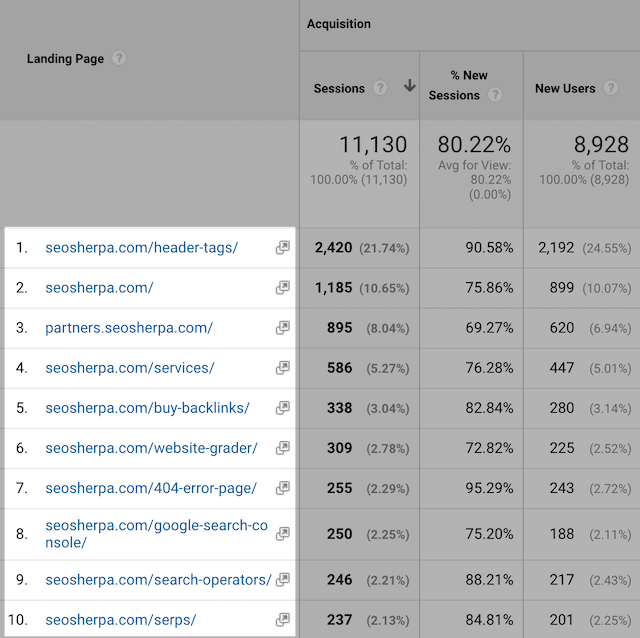
Then, reorder the list for ‘Goal Conversion Rate’ (highest to lowest) to find your conversion champions.
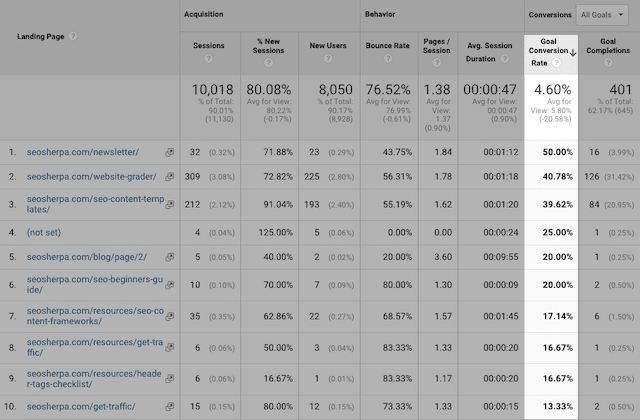
Finally login to your CMS and add links from your top traffic champs to your top conversion champs.
Use a compelling call to action to maximize conversions.
Bonus Tip
If ever you find yourself at a proverbial dead-end.
And cannot find a seamless way to include your link into existing content.
You can merely add a related post link at the end of a paragraph pointing to the page you want to promote.
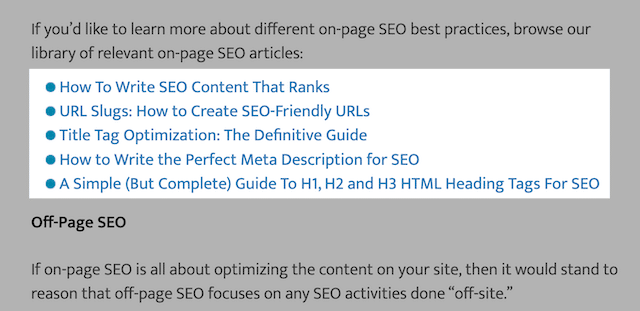
Just like Karl did above.
Now It’s Your Turn
I hope you enjoyed this ultimate guide to internal links.
Now I’d like to hear from you. Which internal linking strategy from today’s guide are you going to use first?
Will you leverage your site’s power pages? Or are you going to optimize for first link priority?
Let me know by leaving a quick comment below.
I’d LOVE to hear from you.
